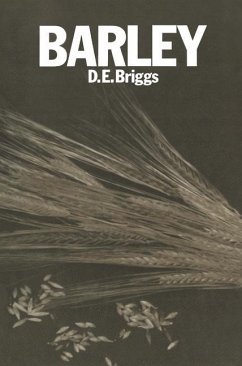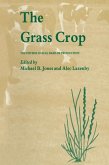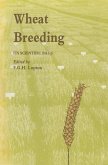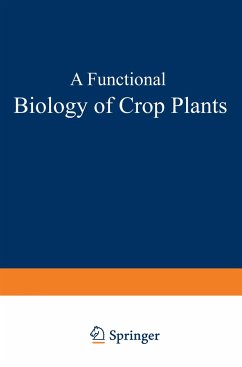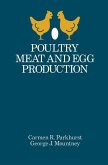Dennis E. Briggs
Barley
Dennis E. Briggs
Barley
- Broschiertes Buch
- Merkliste
- Auf die Merkliste
- Bewerten Bewerten
- Teilen
- Produkt teilen
- Produkterinnerung
- Produkterinnerung
This book was written to provide an integrated account of barley, induding its cultivation, nature and uses. An attempt has been made to cut across the unjustified and obstructive divisions between pure science, applied science, technology, botany, biochemistry, agronomy, and so on. Limitations of space preclude the use of more illustrative material or references, or even complete accounts of various topics. However sufficient information is given to enable the reader to understand the general principles and to find his or her way readily into the literature to obtain further information.…mehr
Andere Kunden interessierten sich auch für
![The Grass Crop The Grass Crop]() Michael JonesThe Grass Crop39,99 €
Michael JonesThe Grass Crop39,99 €![Wheat Breeding Wheat Breeding]() F. LuptonWheat Breeding39,99 €
F. LuptonWheat Breeding39,99 €![The Biology of Wool and Hair The Biology of Wool and Hair]() G. E. RogersThe Biology of Wool and Hair38,99 €
G. E. RogersThe Biology of Wool and Hair38,99 €![A Functional Biology of Crop Plants A Functional Biology of Crop Plants]() Vincent P. GutschickA Functional Biology of Crop Plants39,99 €
Vincent P. GutschickA Functional Biology of Crop Plants39,99 €![Anaerobic Bacteria Anaerobic Bacteria]() K. T. HollandAnaerobic Bacteria39,99 €
K. T. HollandAnaerobic Bacteria39,99 €![Poultry Meat and Egg Production Poultry Meat and Egg Production]() G. J. MountneyPoultry Meat and Egg Production38,99 €
G. J. MountneyPoultry Meat and Egg Production38,99 €![Trends in Photobiology Trends in Photobiology]() Trends in Photobiology39,99 €
Trends in Photobiology39,99 €-
-
-
This book was written to provide an integrated account of barley, induding its cultivation, nature and uses. An attempt has been made to cut across the unjustified and obstructive divisions between pure science, applied science, technology, botany, biochemistry, agronomy, and so on. Limitations of space preclude the use of more illustrative material or references, or even complete accounts of various topics. However sufficient information is given to enable the reader to understand the general principles and to find his or her way readily into the literature to obtain further information. Emphasis has been placed on general principles rather than details. In becoming familiar with the literature one becomes acquainted with the effects of the cereal or religion, the English language and the development of agriculture and biochemistry. The comparison between 'parallel literatures' is often stimulating also. For example one is forced to conclude that many of the agricultural problems of poor 'seed vigour' would be overcome if seedsmen used the maltsters techniques for breaking dormancy and speeding 'post-harvest maturation'. Barley is the world's fourth most important cereal after wheat, rice, and maize. It is the most widely cultivated, being grown from the equator to 700N (Scandinavia), from the humid regions of Europe and Japan to the Saharan and Asiatic Oases, and from below sea level in Palestine to high up mountains in the Himalayas, E. Africa and S. America. Some where in the world it is being sown or harvested at every time of the year.
Hinweis: Dieser Artikel kann nur an eine deutsche Lieferadresse ausgeliefert werden.
Hinweis: Dieser Artikel kann nur an eine deutsche Lieferadresse ausgeliefert werden.
Produktdetails
- Produktdetails
- Verlag: Springer Netherlands / Springer, Berlin
- Softcover reprint of the original 1st ed. 1978
- Seitenzahl: 636
- Erscheinungstermin: 12. Oktober 2011
- Englisch
- Abmessung: 235mm x 155mm x 34mm
- Gewicht: 949g
- ISBN-13: 9789400957176
- ISBN-10: 9400957173
- Artikelnr.: 39492005
- Herstellerkennzeichnung
- Springer-Verlag GmbH
- Tiergartenstr. 17
- 69121 Heidelberg
- ProductSafety@springernature.com
- Verlag: Springer Netherlands / Springer, Berlin
- Softcover reprint of the original 1st ed. 1978
- Seitenzahl: 636
- Erscheinungstermin: 12. Oktober 2011
- Englisch
- Abmessung: 235mm x 155mm x 34mm
- Gewicht: 949g
- ISBN-13: 9789400957176
- ISBN-10: 9400957173
- Artikelnr.: 39492005
- Herstellerkennzeichnung
- Springer-Verlag GmbH
- Tiergartenstr. 17
- 69121 Heidelberg
- ProductSafety@springernature.com
1 The Morphology of Barley; the Vegetative Phase.- 1.1 Introduction.- 1.2 The quiescent barley grain.- 1.3 Changes in the germinating grain.- 1.4 The growth of the stem and leaves.- 1.5 The root system.- 1.6 Plant morphology and lodging.- References.- 2 The Morphology of the Reproductive Parts in Barley.- 2.1 Introduction.- 2.2 The development of the ear.- 2.3 Variations in the form of grains.- 2.4 The ear.- 2.5 Some implications of the wide variety of forms of barley.- References.- 3 The Origin and Classification of Barleys.- 3.1 Introduction.- 3.2 Classifications of barleys.- 3.3 The position of barley within the Gramineae.- 3.4 The origin of cultivated barley.- References.- 4 The Biochemistry of Barley.- 4.1 Introduction.- 4.2 Carbohydrates.- 4.3 The glycolytic sequence, the pentose phosphate shunt and the tricarboxylic acid cycle.- 4.4 Barley lipids.- 4.5 Photosynthesis and photorespiration.- 4.6 The formation of porphyrins.- 4.7 Phenolic and aromatic substances.- 4.8 Amino acid metabolism.- 4.9 The metabolism of some amines.- 4.10 Nucleic acids, and some other nitrogenous substances.- 4.11 Barley proteins.- References.- 5 Grain Quality and Germination.- 5.1 Introduction.- 5.2 Sampling tests with small numbers of grains.- 5.3 Grain evaluation.- 5.4 The penetration of water, and other substances, into grain.- 5.5 Testing for grain germinability.- 5.6 Vigour.- 5.7 Dormancy.- 5.8 The gas exchange of germinating grains.- 5.9 The chemical composition of the quiescent grain.- 5.10 Biochemical changes in germinating grain.- 5.11 Embryo culture in vitro.- 5.12 The mobilization of the endosperm reserves.- References.- 6 The Growth of the Barley Plant.- 6.1 The description of growth.- 6.2 Sequential changes in the growth of the plant.- 6.3 The composition of the growing plant.- 6.4 The composition of the growing grain.- 6.5 Root growth.- 6.6 Water supplies.- 6.7 Water stress.- 6.8 Mineral requirements.- 6.9 The uptake and release of substances by roots.- 6.10 Coleoptile growth and gravity perception.- 6.11 Leaf unrolling and greening.- 6.12 Leaf senescence.- 6.13 Growth regulation.- 6.14 Temperature and growth.- 6.15 Cold hardiness.- 6.16 Vernalization.- 6.17 Some effects of light.- 6.18 Some factors that control yield.- References.- 7 Agricultural Practices and Yield.- 7.1 Introduction.- 7.2 Soil preparation.- 7.3 The choice of seed; sowing.- 7.4 Nutrient supply and barley yield.- 7.5 Some chemical treatments.- 7.6 Damaging factors.- 7.7 Water supplies and yield.- 7.8 Barley as forage.- 7.9 Harvesting the grain.- 7.10 Actual and potential yields.- References.- 8 Production and Harvesting Machinery.- 8.1 Introduction.- 8.2 Irrigation and drainage.- 8.3 Tillage.- 8.4 Sowing.- 8.5 Post-sowing treatments.- 8.6 Harvesting and threshing barley.- 8.7 Straw.- 8.8 Harvesting the whole plant.- 8.9 Conclusions.- References.- 9 Weeds, Pests and Diseases in the Growing Crop.- 9.1 Weeds and the need to control them.- 9.2 Weed control.- 9.3 The economics of weed control.- 9.4 Nematode pests.- 9.5 Molluscs.- 9.6 Birds and mammals.- 9.7 Insect and some other pests.- 9.8 Virus diseases of barley.- 9.9 Bacterial diseases.- 9.10 Fungal diseases.- 9.11 Some general considerations.- References.- 10 The Reception and Storage of Whole Plants and Grain. The Micro-organisms and Pests of Stored Grain.- 10.1 Introduction.- 10.2 Barley hay.- 10.3 Straw.- 10.4 Barley silage.- 10.5 Grain reception.- 10.6 Handling grain.- 10.7 Weighers.- 10.8 Cleaning and grading grain.- 10.9 Drying principles.- 10.10 Grain drying in practice.- 10.11 Grain storage facilities.- 10.12 Seedlongevity and grain deterioration.- 10.13 Micro-organisms in grain.- 10.14 Insects and mites.- 10.15 The mites of stored grain.- 10.16 Insecticides and fumigants.- 10.17 Rodents and their control.- References.- 11 Barley Genetics.- 11.1 Introduction.- 11.2 The inheritance of 'distinct' factors.- 11.3 Cytology and chromosome behaviour.- 11.4 Chromosomal abnormalities.- 11.5 Ploidy levels.- 11.6 Mutations and mutagenesis.- 11.7 The expression of some mutant and other genes.- 11.8 The genetics of complex characters.- References.- 12 Barley Improvement.- 12.1 Introduction.- 12.2 Plant introductions, and adapted forms.- 12.3 Plant selections.- 12.4 Mutation breeding.- 12.5 Hybridization.- 12.6 Crossing barley.- 12.7 The choice of parents.- 12.8 Selection sequences applied to hybrid progenies.- 12.9 Competition and 'natural selection' in barley.- 12.10 Breeding for quality.- 12.11 Some other objectives in breeding.- 12.12 Breeding for higher yields.- 12.13 The quantitative evaluation of parents.- 12.14 'Hybrid' barley.- 12.15 Trial procedures.- 12.16 The multiplication of seed.- 12.17 Conclusion.- References.- 13 Some Actual and Potential Uses of Barley.- 13.1 Introduction.- 13.2 Barley grain; a source of starch and protein.- 13.3 Minor uses of straw.- 13.4 Straw in building.- 13.5 Animal bedding, litter, farmyard manure and compost.- 13.6 Soil protection, conditioning, or replacement.- 13.7 Some industrial uses of barley.- 13.8 Paper, cardboard and millboard.- References.- 14 Barley for Animal and Human Food.- 14.1 Introduction.- 14.2 The nutritional requirements of animals.- 14.3 Forage and hay.- 14.4 Silage.- 14.5 Barley straw.- 14.6 Barley grain.- 14.7 By-products for animal feed, derived from barley.- 14.8 Non-alcoholic beverages.- 14.9 Other potentialfeeding stuffs.- 14.10 The technology of preparing grain for food.- 14.11 Future uses of barley as food.- References.- 15 Malting.- 15.1 Introduction.- 15.2 The selection and acceptance of malting barley.- 15.3 Barley handling.- 15.4 Steeping.- 15.5 Germination equipment.- 15.6 Kilns and kilning.- 15.7 Malt analyses.- 15.8 Changes that occur in the malting grain.- References.- 16 Some Uses of Barley Malt.- 16.1 Introduction.- 16.2 Mashing.- 16.3 Some aspects of yeast metabolism.- 16.4 Malt extracts and barley syrups.- 16.5 Brewing beer.- 16.6 Malt vinegar.- 16.7 Distilled 'potable spirits'.- References.
1 The Morphology of Barley; the Vegetative Phase.- 1.1 Introduction.- 1.2 The quiescent barley grain.- 1.3 Changes in the germinating grain.- 1.4 The growth of the stem and leaves.- 1.5 The root system.- 1.6 Plant morphology and lodging.- References.- 2 The Morphology of the Reproductive Parts in Barley.- 2.1 Introduction.- 2.2 The development of the ear.- 2.3 Variations in the form of grains.- 2.4 The ear.- 2.5 Some implications of the wide variety of forms of barley.- References.- 3 The Origin and Classification of Barleys.- 3.1 Introduction.- 3.2 Classifications of barleys.- 3.3 The position of barley within the Gramineae.- 3.4 The origin of cultivated barley.- References.- 4 The Biochemistry of Barley.- 4.1 Introduction.- 4.2 Carbohydrates.- 4.3 The glycolytic sequence, the pentose phosphate shunt and the tricarboxylic acid cycle.- 4.4 Barley lipids.- 4.5 Photosynthesis and photorespiration.- 4.6 The formation of porphyrins.- 4.7 Phenolic and aromatic substances.- 4.8 Amino acid metabolism.- 4.9 The metabolism of some amines.- 4.10 Nucleic acids, and some other nitrogenous substances.- 4.11 Barley proteins.- References.- 5 Grain Quality and Germination.- 5.1 Introduction.- 5.2 Sampling tests with small numbers of grains.- 5.3 Grain evaluation.- 5.4 The penetration of water, and other substances, into grain.- 5.5 Testing for grain germinability.- 5.6 Vigour.- 5.7 Dormancy.- 5.8 The gas exchange of germinating grains.- 5.9 The chemical composition of the quiescent grain.- 5.10 Biochemical changes in germinating grain.- 5.11 Embryo culture in vitro.- 5.12 The mobilization of the endosperm reserves.- References.- 6 The Growth of the Barley Plant.- 6.1 The description of growth.- 6.2 Sequential changes in the growth of the plant.- 6.3 The composition of the growing plant.- 6.4 The composition of the growing grain.- 6.5 Root growth.- 6.6 Water supplies.- 6.7 Water stress.- 6.8 Mineral requirements.- 6.9 The uptake and release of substances by roots.- 6.10 Coleoptile growth and gravity perception.- 6.11 Leaf unrolling and greening.- 6.12 Leaf senescence.- 6.13 Growth regulation.- 6.14 Temperature and growth.- 6.15 Cold hardiness.- 6.16 Vernalization.- 6.17 Some effects of light.- 6.18 Some factors that control yield.- References.- 7 Agricultural Practices and Yield.- 7.1 Introduction.- 7.2 Soil preparation.- 7.3 The choice of seed; sowing.- 7.4 Nutrient supply and barley yield.- 7.5 Some chemical treatments.- 7.6 Damaging factors.- 7.7 Water supplies and yield.- 7.8 Barley as forage.- 7.9 Harvesting the grain.- 7.10 Actual and potential yields.- References.- 8 Production and Harvesting Machinery.- 8.1 Introduction.- 8.2 Irrigation and drainage.- 8.3 Tillage.- 8.4 Sowing.- 8.5 Post-sowing treatments.- 8.6 Harvesting and threshing barley.- 8.7 Straw.- 8.8 Harvesting the whole plant.- 8.9 Conclusions.- References.- 9 Weeds, Pests and Diseases in the Growing Crop.- 9.1 Weeds and the need to control them.- 9.2 Weed control.- 9.3 The economics of weed control.- 9.4 Nematode pests.- 9.5 Molluscs.- 9.6 Birds and mammals.- 9.7 Insect and some other pests.- 9.8 Virus diseases of barley.- 9.9 Bacterial diseases.- 9.10 Fungal diseases.- 9.11 Some general considerations.- References.- 10 The Reception and Storage of Whole Plants and Grain. The Micro-organisms and Pests of Stored Grain.- 10.1 Introduction.- 10.2 Barley hay.- 10.3 Straw.- 10.4 Barley silage.- 10.5 Grain reception.- 10.6 Handling grain.- 10.7 Weighers.- 10.8 Cleaning and grading grain.- 10.9 Drying principles.- 10.10 Grain drying in practice.- 10.11 Grain storage facilities.- 10.12 Seedlongevity and grain deterioration.- 10.13 Micro-organisms in grain.- 10.14 Insects and mites.- 10.15 The mites of stored grain.- 10.16 Insecticides and fumigants.- 10.17 Rodents and their control.- References.- 11 Barley Genetics.- 11.1 Introduction.- 11.2 The inheritance of 'distinct' factors.- 11.3 Cytology and chromosome behaviour.- 11.4 Chromosomal abnormalities.- 11.5 Ploidy levels.- 11.6 Mutations and mutagenesis.- 11.7 The expression of some mutant and other genes.- 11.8 The genetics of complex characters.- References.- 12 Barley Improvement.- 12.1 Introduction.- 12.2 Plant introductions, and adapted forms.- 12.3 Plant selections.- 12.4 Mutation breeding.- 12.5 Hybridization.- 12.6 Crossing barley.- 12.7 The choice of parents.- 12.8 Selection sequences applied to hybrid progenies.- 12.9 Competition and 'natural selection' in barley.- 12.10 Breeding for quality.- 12.11 Some other objectives in breeding.- 12.12 Breeding for higher yields.- 12.13 The quantitative evaluation of parents.- 12.14 'Hybrid' barley.- 12.15 Trial procedures.- 12.16 The multiplication of seed.- 12.17 Conclusion.- References.- 13 Some Actual and Potential Uses of Barley.- 13.1 Introduction.- 13.2 Barley grain; a source of starch and protein.- 13.3 Minor uses of straw.- 13.4 Straw in building.- 13.5 Animal bedding, litter, farmyard manure and compost.- 13.6 Soil protection, conditioning, or replacement.- 13.7 Some industrial uses of barley.- 13.8 Paper, cardboard and millboard.- References.- 14 Barley for Animal and Human Food.- 14.1 Introduction.- 14.2 The nutritional requirements of animals.- 14.3 Forage and hay.- 14.4 Silage.- 14.5 Barley straw.- 14.6 Barley grain.- 14.7 By-products for animal feed, derived from barley.- 14.8 Non-alcoholic beverages.- 14.9 Other potentialfeeding stuffs.- 14.10 The technology of preparing grain for food.- 14.11 Future uses of barley as food.- References.- 15 Malting.- 15.1 Introduction.- 15.2 The selection and acceptance of malting barley.- 15.3 Barley handling.- 15.4 Steeping.- 15.5 Germination equipment.- 15.6 Kilns and kilning.- 15.7 Malt analyses.- 15.8 Changes that occur in the malting grain.- References.- 16 Some Uses of Barley Malt.- 16.1 Introduction.- 16.2 Mashing.- 16.3 Some aspects of yeast metabolism.- 16.4 Malt extracts and barley syrups.- 16.5 Brewing beer.- 16.6 Malt vinegar.- 16.7 Distilled 'potable spirits'.- References.

